VMAQ-2
| Marine Tactical Electronic Warfare Squadron 2 | |
|---|---|
|
VMAQ-2 Insignia | |
| Active | September 15, 1952 - present |
| Country | United States |
| Allegiance | United States of America |
| Branch | United States Marine Corps |
| Type | Attack and Electronic Warfare |
| Role | Electronic Warfare |
| Part of |
Marine Aircraft Group 14 2nd Marine Aircraft Wing |
| Garrison/HQ | Marine Corps Air Station Cherry Point |
| Nickname(s) |
"Death Jesters" "Panthers" (1993-2000) "Playboys" (1955-1993) "Widowmakers" |
| Motto(s) | Can Do Easy |
| Tail Code | CY |
| Engagements |
Operation El Dorado Canyon Operation Desert Storm Operation Decisive Endeavor Operation Allied Force Operation Enduring Freedom Operation Iraqi Freedom * 2003 invasion of Iraq |
| Commanders | |
| Current commander | LtCol J.W. "Chester" Beaven |
Marine Tactical Electronic Warfare Squadron 2 (VMAQ-2) is a United States Marine Corps electronic warfare squadron consisting of EA-6B Prowler jets. The squadron is based at Marine Corps Air Station Cherry Point, North Carolina and falls under the command of Marine Aircraft Group 14 (MAG-14) and the 2nd Marine Aircraft Wing (2nd MAW).
Mission
Support the Marine Air-Ground Task Force (MAGTF) Commander by conducting airborne electronic warfare, day or night, under all weather conditions during Expeditionary, Joint, or Combined operations.
History
Early years
VMAQ-2 boasts a proud history of service to the Marine Corps through its predecessor squadrons flying various electronic warfare aircraft, to include: the AD-5 Skyraider, the EF-10 Skyknight, and the EA-6A Intruder. VMC-2 was the original composite squadron (combined aerial photographic reconnaissance and electronic warfare capability) in Marine Corps aviation. It was commissioned at Marine Corps Air Station Cherry Point on September 15, 1952 evolving from the former Airborne Early Warning and Electronic Counter Measures section of the Wing Headquarters Squadron. On December 1, 1955, the squadron was redesignated as VMCJ-2 after former Marine Photographic Squadron 2 (VMJ-2) was decommissioned and joined VMC-2. As 1955 was also the year Playboy magazine was first published, it soon followed that the squadron adopted the Playboy name and logo with their permission. In December 1960, VMCJ-2 provided electronic and photographic intelligence during the Cuban Missile Crisis that enabled President Kennedy to make key decisions that would lead to the removal of Soviet military equipment from Cuba. In 1964 VMCJ-2 participated in Operation Steel Pike, the largest amphibious training exercise in history. The unit sailed from Morehead City, NC to the Naval Base at Rota, Spain and flew both photographic and electronic warfare missions during the exercise.
Vietnam
Less than three years after the end of the Cuban Missile Crisis, some of the same VMCJ-2 aircrews deployed with VMCJ-1 to Vietnam and applied their lessons learned against Cuba as the EF-10Bs began to provide ECM support for air strikes against North Vietnamese targets. Beginning in the Spring of 1966 the squadron began sending Marines to join VMCJ-1 in Vietnam for 13-month tours. In late November 1965, VMCJ-2 received the first EA-6A Intruder. With the rapidly escalating North Vietnamese air defenses this new EW aircraft was anxiously awaited by VMCJ-1 still flying the outdated EF-10Bs. However, the initial EW systems delivered with the new aircraft proved unsuitable for the mission without some major modifications. Given the urgency, the decision was made to make the modifications by a contractor team on-site at VMCJ-2. The success of this effort was due to the dedicated support of VMCJ-2 personnel who worked tirelessly to get the aircraft ready for deployment to Vietnam.

During this same time period the squadron received the first of its RF-4Bs and for several months the squadron was flying four different aircraft types. In October, 1966 VMCJ-2 sent six EA-6As with full maintenance capability to Danang, Vietnam as a VMCJ-1 replacement cadre. The squadron would continue to provide replacement aircrews and updated aircraft to VMCJ-1 in Vietnam.
In 1971 the squadron deployed the first EA-6A detachment aboard USS Forrestal (CV-59) for a Mediterranean cruise that lasted 10 months with cross decking to USS Saratoga (CV-60) and USS America (CV-66). In April 1972 the squadron diverted an EA-6A detachment that was scheduled to deploy on the Saratoga in the Mediterranean to WESTPAC to join VMCJ-1 at NAS Cubi Point. The VMCJ-2 detachment operated in concert with VMCJ-1 to support strikes against North Vietnam under Operation Linebacker that ended with the release of the U.S. POWs early in 1973.
Cold War Sea Service

After its re-designation in 1975, VMAQ-2 deployed detachments of EA-6A aircraft [designated Detachments Alpha, Bravo, and Charlie] and EA-6B aircraft [designated Detachments Xray, Yankee, and Zulu] on a continuous basis in support of Marine forces in the Western Pacific and in support of Fleet Commanders on aircraft carriers, including lengthy deployments on the Midway, Nimitz, America, and Saratoga. In 1977, the squadron transitioned to the EA-6B Prowler with the Improved Capability (ICAP) EW suite. In 1986, a detachment of the squadron participated in U.S. raids against Libya as part of Operation El Dorado Canyon.
The Gulf War & The Balkans
In 1990, VMAQ-2 deployed Detachments Yankee and Zulu to Bahrain in support of Operation Desert Shield and Operation Desert Storm, flying nearly 500 combat sorties in a six-week period. Detachment X-Ray was already forward deployed with the 1st Marine Aircraft Wing in the Western Pacific for their routine six-month rotation and would remain there for a total of 410 days - more than double their scheduled deployment time - the longest continuous deployment in Marine aviation history during peacetime.
On 1 July 1992, VMAQ-2, the largest tactical squadron in Marine Aviation, was reorganized into three squadrons: VMAQ-1, VMAQ-2, and VMAQ-3. In 1993, outside pressure forced the Marine Corps to direct the squadron to change their name and logo from "Playboys" to something more politically correct. After several ideas were rejected the squadron chose Panthers as the new name and began using the logo (with permission) of the National Football League's Carolina Panthers.
VMAQ-2’s next assignment led them to Aviano Air Base, Italy, in March 1996 in support of Operation Decisive Endeavor. This operation tasked VMAQ-2 with missions over Bosnia and Herzegovina. Specifically, VMAQ-2 Prowlers provided Suppression of Enemy Air Defenses (SEAD) support to British Harriers performing reconnaissance flights over weapons containment sites in these two areas of operation. In 1997, VMAQ-2 once again deployed to Aviano Air Base. However, this time it was in support of Operation Deliberate Guard. VMAQ-2 was tasked with flying missions over Bosnia to cover the Bosnian elections. On February 3, 1998 an EA-6B Prowler, BuNo 163045, callsign Easy 01, from VMAQ-2, struck a cable supporting a gondola in Cavalese, Italy. The cable was severed and 20 people in the cabin plunged over 80 metres to their deaths. The plane had wing and tail damage but was able to return to the base.[1] It was the squadron's first major mishap in over 60,000 flight hours spanning nearly fifteen years of worldwide operations.
In February 1999, VMAQ-1, VMAQ-2, VMAQ-3, and VMAQ-4 received the order to again deploy to Aviano in support of Operation Noble Anvil and possible subsequent combat operations against the Federal Republic of Yugoslavia. After diplomatic attempts to resolve the Kosovo crisis failed, Operation Allied Force began. VMAQ-2 launched day and night sorties to provide jamming and HARM support to U.S. and NATO missions. VMAQ-2 also provided support for armed reconnaissance missions, day and night battlefield air interdiction strikes, and combat search and rescue efforts of downed allied aircrew. When Operation Allied Force came to an end, VMAQ-2 had flown 2151.5 combat hours, 464 combat sorties, and fired 57 High speed Anti-Radiation Missiles (HARM) against the Federal Republic of Yugoslavia.
Global War on Terror

In February 2003, VMAQ-2 deployed to Prince Sultan Air Base, Kingdom of Saudi Arabia, initially in support of Operation ENDURING FREEDOM and then Operation IRAQI FREEDOM. VMAQ-2 logged over 1000 combat hours in under 60 days in the war to liberate Iraq.
VMAQ-2 deployed to Tallil Air Base, Iraq, for Operation IRAQI FREEDOM II from July 2004 through January 2005 and became the first Prowler squadron to operate from Iraqi soil. The squadron logged over 2000 mishap-free combat hours and attained 10,000 Mishap Free Flight Hours during the same period. VMAQ-2 was subsequently chosen as the Marine Corps Aviation Association 2005 Prowler squadron of the year.
In January 2006, VMAQ-2 deployed to Al Asad, Iraq in support of Operation IRAQI FREEDOM 05-07. VMAQ-2 flew 691 combat missions for 3286.7 combat flight hours and supported 975 Joint Tactical Air Requests (JTARS). This rigorous operational tempo resulted in four times the normal airframe utilization rate.
In July 2007, VMAQ-2 returned to Al Asad, Iraq in support of Operation IRAQI FREEDOM 06-08. During the deployment, VMAQ-2 flew 821 combat missions for a total of 4423.0 combat flight hours while supporting Coalition ground forces. This sustained tempo led not only to the highest utilization rate for any Prowler squadron but also for any Type/Model/Series in the Marine Corps.
Awards
VMAQ-2’s awards include the Navy Unit Commendation Streamer with two Bronze Stars for the Cuban Missile Crisis and actions against Iraq, the Meritorious Unit Commendation Streamer with two Bronze Stars, the Marine Corps Expeditionary Streamer with two Bronze Stars, the National Defense Service Streamer with two Bronze Stars, the Armed Forces Expeditionary Streamer with one Bronze Star for Cuban and Dominican Republic service, and the Southwest Asia Service Streamer with two Bronze Stars.
See also
References
- Notes
 This article incorporates public domain material from websites or documents of the United States Marine Corps.
This article incorporates public domain material from websites or documents of the United States Marine Corps.
- ↑ Stamford, Lincs., U.K.: Air Forces Monthly, May 1998, Number 122, page 59.
- Bibliography



